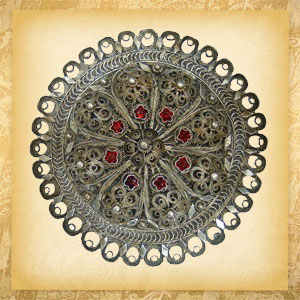

Processing and using of metals took very important position in craft production. Metal processing crafts include blacksmithing, gunsmithing, swordsmithing, "zildzije" (production of tools from brass and bronze), locksmithing, coppersmithing and silversmithing. Coppersmiths and silversmiths dealt with precise artistic processing of metals. Silversmiths made gold and silver jewellery.
Silversmith's street was founded in the first half of 16th century at location of today's Gazi Husref-bey's Street and Mali Kujundžiluk. Goldsmiths work mainly in this street today. The filigree craft originates from silversmith's craft, but by the time, filigree workers perfected their skills and became independent, as a separate trade. At the beginning, silversmiths made pieces of jewellery, while filigree-workers made precise ornaments of bent and knitted silver wire to fill voids in the pieces of jewellery, or the ornaments were just glued on the surface.
Filigree is Latin word, which means „something precise“. Since the Turkish word for filigree is „telkar“, we suggest that filigree-craft was brought in this region through Ragusans. The silver, used by our craftsmen, had been mainly extracted from various minerals from Kresevo and Srebrenica regions. A thin wire would be made first and then it was knitted with great precision and soldered for a basis, using special silver powder. Perfect forms were and are still made from a silver wire, thus the filigree art can be rightfully qualified as an art or applied art.
Separating from silversmiths, the filigree workers began to make not only jewellery, but also items of use, such as jewellery and money boxes, ladies' bags, tobacco-pipes, cigarette-cases, etc. Beside jewellery, their filigree work was used to decorate weapon, respectively, sword handles and different kinds of guns. Filigree-workers designed various jewellery articles, as they still do, including „belenzuke“ and „halhale“ (kinds of bracelets), ear-rings, brooches, pendants, „teperluke“ – decorations for women's caps, belt buckles and belts. The filigree craft and silversmithing have survived till nowadays, and there are few craftsmen who preserve tradition of jewellery designing. We hope that they will transfer their skills to young people, thus the art of silver and gold processing will not die out in our region.
Tradicija porodice Užičanin počinje od 1864 godine. Tradicionali zanat je sarački (izrada predmeta od kože). Od 1988 godine proširujemo djelatnost i počinjemo sa izradom predmeta od srebra-filigran. Rucna izrada nakita od srebra. Restauracija,opravka,pr ...
SOR RUBIN-ELEGANCE egzistira od 1997 godine kada je u starom dijelu grada Sarajeva na bascarsiji u ulici Kundurdziluk pocela manifakturna proizvodnja, obrada,dorada nakita od dragog i poludragog kamena , te prodaja brendiranih satova.Upredmetnom prostoru ...
Samostalna obrtnička filigranska radnja vl. Čehajić Arman